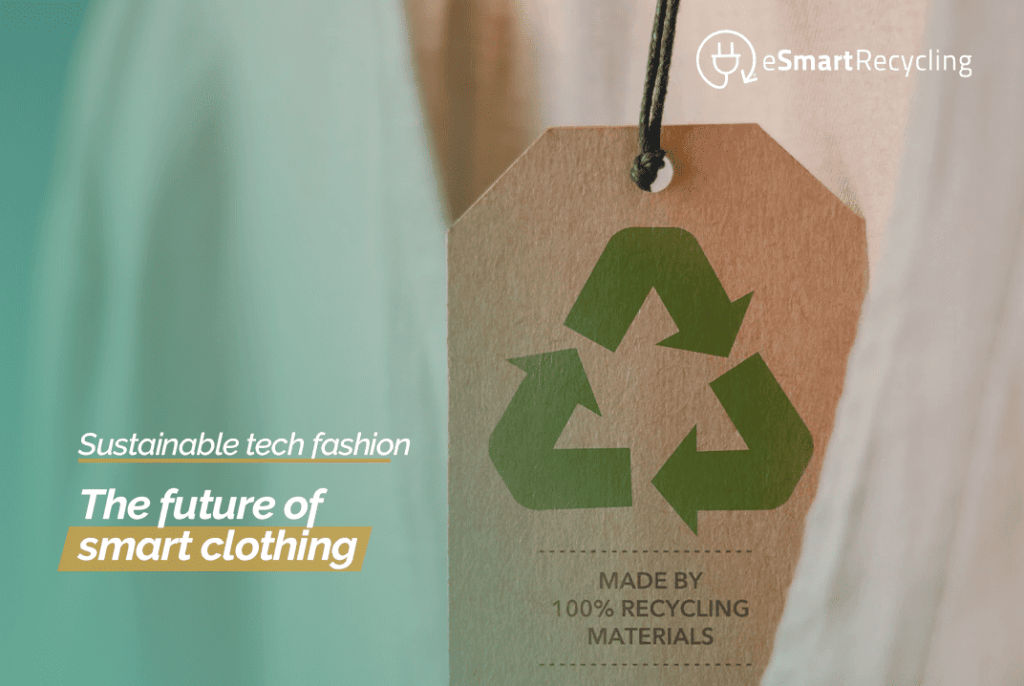
In today’s increasingly digital and technological world, the fashion industry continually evolves to keep up with the latest trends and innovations. Sustainability has become a key focus for many fashion brands, and with the rise of wearable technology, the future of fashion could reach even greater heights. Smart clothing, as it is known, can merge sustainable practices with cutting-edge technology to create a new standard for apparel.
This article will discuss how smart clothing is changing our perception of fashion and the future of this industry.
Smart clothing is a new and revolutionary form of apparel incorporating electronic and digital technology. It can include anything from sensors embedded in the fabric that monitor health and fitness to wearable devices that provide users with real-time information. The primary goal is to offer practical and valuable benefits to the user without compromising aesthetics, comfort, or sustainability.
Traditional clothing production often involves heavy processing, toxic chemicals, and unsustainable materials. In contrast, smart clothing can be made with much more sustainable materials, and many brands opt for recycled or biodegradable materials. Similarly, the production process can consume much less energy. Additionally, as smart clothing is designed to last, it is usually less prone to fast fashion trends, which means it is likely to be used for longer and, therefore, have less impact on the environment.
As technology continues to advance, so does the potential for smart clothing. Soon, we can expect to see a greater variety of garments that include smart technology, such as jackets and other outerwear, as well as more advanced features like climate control and programmable LED lights embedded in the garment. Brands will likely develop and launch apps that accompany the technology, providing a more connected experience between the user and their clothing.
As the popularity of smart clothing increases, many fashion brands are embracing this new trend. One such brand is Nike, which has recently launched a range of technological garments that enhance performance. Their self-lacing shoes, called Adapt, offer a customizable and comfortable fit for footwear. Meanwhile, Levi’s has developed a connected denim jacket that can connect to a mobile app for additional functionalities.
Smart clothing has the potential to revolutionize the fashion industry, providing a more sustainable and practical approach to modern apparel. The demand for wearable technology is on the rise, and as more brands adopt smart clothing, we can expect a more connected and advanced future for fashion.
Fill out the form below to request your electronics recycling pickup.
We’ll coordinate the schedule logistics and follow up with next steps.
Applying circular economy principles to business technology means ensuring that devices, materials, and components are used for as long as possible, repaired, refurbished, reused, and finally recycled safely. For companies committed to sustainability, this is not just an ethical goal: it can generate savings, new revenue streams, and lower regulatory risks.
In the technology field, these are the key principles:
Here are some reasons backed by real data:
Here are some specific ideas any sustainability officer can launch:
We collect used technology, securely destroy data under standards such as HIPAA, evaluate equipment, and allocate about 30% of revenues to repair and donate devices. This way, we help companies meet their social and environmental responsibilities, reduce their waste footprint, and integrate real circular economy practices into their operations.
In addition, we deliver a personalized Impact Report to each company, showing in numbers and visuals the direct results of recycling with us: how many devices were recovered, how much e-waste was processed, how many people gained access to technology, and what environmental benefits were achieved. It’s a transparent tool that turns every action into measurable outcomes that companies can share internally and with their communities.
Circular economy in business technology is not just an environmental ideal: it’s a practical strategy to cut costs, lower risks, strengthen reputation, and create social value. Companies that start now will be better prepared for stricter regulations, demanding consumers, and markets that reward sustainability.
If you are responsible for sustainability, compliance, or risk in a company, the short answer is: yes, outdated technology can become a serious liability in an audit. Here’s why, what risks you should expect, and what you can do about it—with real examples.
When auditors review internal controls over information systems, they want to see processes, hardware, and software that are secure, documented, up to date, and free of critical vulnerabilities. If you are using:
Then you could violate regulatory requirements, accounting standards, or even privacy laws.
For example:
Here are some of the issues auditors might flag if old technology is not managed properly:
Practical steps to keep outdated tech from turning into audit trouble:
Say your finance team still relies on an accounting server running an unsupported operating system. During a SOX audit, the auditor asks about vulnerability patching. If the server is exposed, it could compromise the integrity of financial data. And if decommissioned drives from that server are found without destruction certificates, that could escalate to regulatory concerns.
At eSmart Recycling, when we receive end-of-life equipment, we ensure data destruction is carried out under recognized standards. We also provide certificates of destruction—helpful evidence in audits.
Managing outdated technology with proper documentation and secure disposal practices ensures that your next audit won’t uncover unnecessary liabilities.
That morning in St. Pete, the transit terminal looked different. Families and neighbors showed up with boxes and backpacks filled with laptops, phones, and chargers that had been sitting at home for years. Some devices were scratched, others wouldn’t even turn on, but they all shared the same story: forgotten in a drawer, unused.
At the E-Revolution Drive, people realized that beyond clearing out space at home, recycling can actually change lives.
Recycling electronic equipment is not something extra. In the United States, electronic waste is the fastest-growing waste stream and, according to the Environmental Protection Agency (EPA), it contains materials that can be recovered and reused. Keeping them stored at home or in offices only delays a problem that impacts both the environment and people.
The devices collected went through a simple process: those still working were repaired so someone else could use them. The ones that no longer worked were carefully taken apart piece by piece, recovering metals and plastics that still have value.
Nothing ended up in the trash, and every part found a new purpose.
During the day, we saw neighbors arrive with backpacks, boxes, and even plastic bags filled with forgotten devices. Phones, laptops, and chargers that had been collecting dust for years. People handed them over with a smile, relieved to know that their old tech would have a better destination. That mix of relief and excitement was what made the E-Revolution Drive so special.
The partnership with PSTA made perfect sense. Many people who rely on public transit also face the digital divide. Having access to a device means they can:
That’s why it matters. What looks like an old paperweight to you could be the key for someone else to regain connection and independence in their daily life.
The event was covered by FOX 13 News Tampa Bay, showing how the community embraced tech recycling without complications.
Seeing it on local television helped spread a simple message: we all have a drawer full of cables or an old phone, and letting them go is easier than we think.
For sustainability leaders, initiatives like the E-Revolution Drive send a clear message:
The E-Revolution Drive highlighted something we all know but often overlook: we all have devices at home we no longer use, and they can serve a better purpose.
That day in Tampa, we saw how bringing in an old phone, a laptop, or any other device can truly make an impact. There was no need for a big speech—just people willing to recycle and share what they no longer needed.
Today, many companies are proving that technological sustainability is no longer just a good intention but a concrete line of action. Here, I’ll show what leading U.S. companies are doing, how they are making it happen, and what sustainability managers can learn to join this movement. At eSmart Recycling, we are also part of this change, contributing through secure recycling, refurbishment, and donations.
By technological sustainability, I mean reducing the environmental damage caused by technology: lower carbon emissions, less water use, more recycling/refurbishment, modular design, responsible materials, renewable energy, and so on.
Some frequent questions are:
Here are some concrete examples:
Based on what these companies are doing, here are some actionable takeaways:
| Practice | What it means in action | How to measure progress |
| Modular design & recycled materials | Easy-to-repair equipment, bio-based plastics, recycled aluminum, reclaimed cobalt/copper/steel | % recycled materials, repairability rating, failure/RMA rate |
| 24/7 clean energy & carbon-free ops | Renewable PPAs, co-located data centers, and adding nuclear where applicable | % clean energy, scope 1–3 emissions, contracted renewable capacity |
| Measurement, transparency & reporting | Audits, public reports, supplier engagement, and external validation | Annual sustainability reports, third-party certifications, and year-over-year emission reductions |
| Circular lifecycle | Refurbish/remanufacture, recycle, donate equipment still usable | Units refurbished/donated, % of devices recycled, electronic waste diverted |
At eSmart Recycling, we contribute on multiple fronts:
Companies like Google and Microsoft show that technological sustainability requires bold goals, transparency, supplier collaboration, and concrete actions such as clean energy, responsible materials, and circular strategies. For those leading sustainability today, adopting measurable steps brings real benefits: stronger reputation, regulatory compliance, and reduced environmental risk. With the right commitment, meaningful results are within reach.
Procrastination may not initially seem like an environmental issue, but it does have real costs for companies, society, and the planet. When you postpone tasks, you’re not only losing productivity—you may also be contributing to wasted energy, higher indirect emissions, and added stress on systems already under pressure. Let’s break down what this means, what research says, and what business leaders in sustainability can do about it.
For us, sustainability is about environmental care, social responsibility, and conscious resource use. Procrastination can influence each of these areas:
A study by Economist Impact found that U.S. knowledge workers lose around $468 billion per year due to distractions, including unproductive meetings, unnecessary messages, and a lack of focus.
The same report shows:
There aren’t studies that measure “emissions caused by procrastination,” but research does link working hours to household carbon footprints. One study found that households with longer working hours tend to produce more CO₂, even if the increase per hour is moderate.
The logic: more hours mean more energy for lighting, HVAC, equipment use, and transportation. If procrastination stretches those hours unnecessarily, it adds to energy waste and indirect emissions.
A large-scale study (22,053 participants) showed that high procrastination levels correlate with lower wages, less job stability, and a higher likelihood of underemployment or unemployment.
This doesn’t just harm individuals—it also affects companies’ ability to retain talent, plan responsibly, and uphold long-term social responsibility goals.
It depends on awareness and what you do with that time. In rare cases:
But most of the time, procrastination has a net negative effect.
Your procrastination probably isn’t sustainable if you ignore it. It creates measurable losses in productivity, workplace well-being, and hidden emissions. But with intentional strategies, companies can reduce these hidden costs and align time management with broader sustainability goals. At eSmart Recycling, we believe every form of waste matters—whether it’s old devices sitting in a closet or hours lost to procrastination.
At eSmart Recycling, we know that every device can have a new story to tell. A laptop that once served its purpose in a company can still make a difference when handled responsibly.
Recently, together with the Sheriff’s Hispanic Advisory Council (SHAC) and the Digital Education Foundation, we helped deliver 61 refurbished laptops to students at Davidsen Middle School. That moment reminded us of the true meaning of our work.
It all starts when a company or organization donates its equipment. Our team receives, audits, and performs secure data destruction in accordance with strict standards, including HIPAA and NIST 800-88.
Then, each device is repaired and refurbished by technicians who make sure it can be used again safely and reliably.
Only part of the equipment can be reused. Components that no longer work are sent to certified recycling facilities, ensuring that materials return to the industry instead of ending up in landfills.
When refurbished laptops reach students, everything makes sense. What was once unused equipment for a company becomes a learning tool for a child.
At Davidsen Middle School, the smiles said it all. The school community, together with SHAC and Digital Education Foundation, celebrated a project that connects sustainability with digital access.
These partnerships show how collaboration between private companies, community organizations, and schools can create tangible and lasting results.
At eSmart Recycling, we believe technology doesn’t end when it’s no longer new. Each refurbished device means less waste, fewer emissions, and more access to education and opportunity.
Over the past few years, we’ve worked with companies and organizations across Tampa and other U.S. cities, recovering thousands of devices and giving many of them a new purpose through educational and community programs.
Our goal is to close the loop: collect, secure, refurbish, and deliver where it’s needed most.
Each delivery, like the one at Davidsen Middle School, reminds us how much a used laptop can do.







If you want to know more about the different programs, partners, and overall cool things happening in the eSmart world, share your email with us, and Join the E-Revolution.
